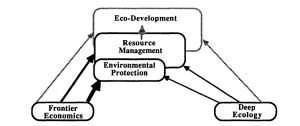The importance of the environment, green thinking, environmental hazards, prioritization mechanisms, and methodology have been a whole new chapter in International Relations, that emerged in the 1960s. Since then it has been in a period of rapid change.
For a long ago there have been an implicit debate going on between environmentalists and economists with the conservation of the planet’s ecology on one side and the industrial development and economic boom on the other. However, in recent decades, a sense of concern and urgency got heightened.
Hence, the environment became an emergent issue and the idea of sustainable development received much attention. Green thinking gained political expression and activist characteristics.
With that, in modern policy-making in International Relations, conceptions are not alone to be politically feasible, and economically and technologically practical but also consider what is ecologically necessary.
This ultimately developed a wider policy-making horizon and ended up being worldwide in its nature by bringing up international treaties for ecological and ozone protection.
The basic paradigms of green thinking and environmental management that evolve from the study of the relationship between man and nature are; ‘deep ecology’, frontier economy’, ‘resource management’, ‘environmental protection’, and ‘eco-development’.

From ideas to politics
The study of Earth’s biological diversity and soil conservation dates back circa 2,000 years ago in China, India, and Peru.
While pollution was regarded with the spread of epidemic disease in Medieval Europe. However, these fields of interest did not give rise to any public activism.
Conservative environmentalists were also in opposition to Liberalists, and rather than the free market, considered the government to be responsible for the protection of the environment and consumption of resources.
In 1924, Aldo Leopold of New Mexico introduced the concept of land ethics. It served as a basis for Green thinking. He argues that humans rather than thinking of themselves as the conqueror of nature should consider themselves as the citizens of it.
A middle-class lobbying group of environmentalists emerged from the late 19th to early 20th century. They were primarily concerned with pollution emerging from the industrial revolution, the urbanization of cities, and wildlife protection.
European countries started wildlife conservation developments by working for better management of national parks and forests and animal protection societies.
In the 1960s came the era of the nuclear and technological race and hence environmentalists gave their thoughts a political expression. Hence the green political movements turned into environmentalist political parties and activist non-governmental organizations.
However, the political goals of these parties were only targeting the grass root managerial levels i.e. promoting environmental values and changing governmental policies regarding it.
The major change occurred when the idea of ‘eco-terrorism’ gained widespread coverage against excessive mining, deforestation, and dumping of chemical and nuclear wastes in land and water bodies.
It significantly included the emission of toxic gases after incidents such as the drastic flooding of Lake Pedder in Australia, the catastrophic nuclear accident in Chornobyl, deforestation in Indonesia and the Amazon Basin, and Niger Delta Oil pollution.
The first green parties on the planet emerged in New Zealand; the Value Party and in Australia; the United Tasmania Group in the 1970s.
In Europe, Switzerland and then Belgium were the earliest to give green members, seats in their national legislatures.
Green political groups also emerged on small scale in the former Soviet Union, Asia, Africa, and South America.
In these regions, however, they could not receive much recognition and public support due to the poorly democratic governments and the developmental crisis these regions were facing.
Paradigms of environmental management
Frontier Economics
This most basic and widely perceived paradigm was first proposed by economist Kenneth Boulding.
According to that nature serves as an infinite supply of resources to be used for humans’ benefit and as an ultimate infinite sink to dump the by-products and waste materials.
For him, the environment is something that was always been there and will remain there to be used as a commodity for human needs to be fulfilled.
For economists, the environment is not something to manage, what should be managed are the negative impacts of the variability of nature and hence are the examples such as pesticides and fertilizers.
They believe that nature is something to be explored, exploited, manipulated, and even sometimes ‘cheated’ in order to meet ends.
An example of this is the ‘tall smokestacks’ that are intentionally made thin and long in order to dodge people and nature. The ultimate goal is the development and progress of human societies and their economies.
This paradigm was initially used to propagate the industrial revolution in the west and developing societies to accommodate the growing population.
However, its importance started decreasing by the 1960s with the emergence of environmentalists, rising as a major resistance to such unilaterally oriented perceptions.
Deep Ecology
This phase of Green thinking, in opposition to frontier economics, puts nature above humans in the hierarchy. However, rather than being technically a governmental or managemental approach, it is only an ethical and moral approach.
Its philosophical approach advocates a vision of ‘Eco-topia’, which propagates harmony with nature and thus considers technological advancements more likely to generate costly and toxic problems instead of development or progress.
It demands reasonable human consumption of natural resources due to them being ‘scarcer’ with the passage of time and equality for all bio species.
Environmental Protection
By the start of the 1960s, pollution and the destruction of habitats started becoming major concerns. By the end of the second major war, every newly emerging state had the urge of becoming part of the developmental race. This made environmentalists start thinking about its consequences.
It was the first time, practical measures and official policies were propagated for green thinking and to devise something achievable in the Ecology vs. Economy sphere.
One major characteristic that differentiates it from previous paradigms is that rather than focusing on how to improve ways of human development in comparison with nature’s flexibility limits, it focused on institutionally revising human actions and rehabilitating nature’s loss.
This paradigm brought the idea of ‘business as usual with a treatment plant’. However, the problem lies in the fact that it is more human-oriented instead of nature-oriented.
The policy-making includes efforts to perceive and manage threats to human health such as controlling pollution in order to save people living nearby. More precisely it has a short-range or unilateral approach, but it does not highlight the efforts or problems that need to resolve in order to save nature.
Resource Management
This paradigm is an emerging and evolving paradigm, which came up with policy-making. It is based on managing climate and environmental resources in order to reduce the consequences of resource exhaustion and the effects of overuse and mismanagement of resources.
These resources are not just labor or economic resources, but all natural resources i.e. soil, water, forests, habitat, wildlife, fisheries, and also the negative resources that led to pollution.
This generated the idea of ‘Global Commons’ which further added up other resources such as the atmosphere particularly the ozone layer, biodiversity, oceanic resources, etc.
Resource management got more highlighted in the 1980s when a technological boom was observed in many newly emerged states and free market and trade growth were more important at that time.
Also meeting the needs of the growing population and debt crisis faced by many societies led to the fulfillment of economic interests only, rather than considering the environmental conditions which resulted in drastic extraction and ultimately destruction of natural resources.
This context of green thinking provided grounds for risk assessment in order to provide biophysical models and initiatives for global common laws, under the umbrella of resource management.
One of the major approaches is economizing the ecology, i.e. providing pollution prevention laws in industries rather than the clean-up mechanism after the damage is done, ecological health monitoring, setting prices for all resources and penalizing polluters, etc.
Eco-Development
Eco-development is the most upgraded form of green thinking paradigms. It is all-encompassing in nature and hence considers economy and ecology both parallel to each other and subjects of Eco.
It propagates economic development which is gravely essential for the growth of a state and its societies but with rational use of natural resources at all economic platforms and modes of development of natural ecosystems, its threshold and exhaustion limits, and patterns.
This paradigm brought with it, the idea of Sustainable Development of all forms of natural and societal resources.
This paradigm rather than the previous ones i.e. economizing the ecology, has adopted the approach to ecologizing the economy, which makes it an eco-centric approach that again is not just bio-centric (ecology) or anthropocentric (economy), but discusses the side-by-side roles and relationships of nature and humans in a society.
It adopts a ‘Holistic approach’ and considers society a part of the region and that regions come together and become a whole ecosphere of the planet Earth.
Rather than how to create or how to remedy, this paradigm discusses how to create ecologically, which puts the creativity and remedial factor in mind from the very initial stages of development, in order to not bear any consequences later.
Conclusion
Growing environmental stress has taken a shape of one of the major factors in shaping the national policies of states.
Climate change, environmental crisis, or imbalanced resource distribution due to exhaustion has contributed to emerging issues and conflicts.
The distribution of waterways is emerging as one of the major conflicts in the present century. The water crisis in the Middle East, the Darfur war in Sudan, and the Indo-Pak Indus water issue are gaining more and more highlights due to the increasing levels of water scarcity in these regions.
Many of the analysts make a clear statement of water being a major ground for another major war in the coming days, where many hostilities have already started heading up on several occasions.
With this, a newly emerging issue of ‘ecological refugees’-people who are leaving their residing areas due to the effects of drastic changes in climate change-has started emerging.
Many of these refugees are perceived as military or political refugees which further engraves the issue of national security.
Increasing Droughts and wildfire situations are also putting great pressure on the destruction of states’ vast agrarian zones and the extinction of natural habitats and biodiversity.
The environmental policy-making paradigms have only been successful in some states due to many reasons e.g. imbalanced resource distribution in the North-South gap and ingrown corruption of poor and developing states leading to environmental issues not being addressed and resolved frequently.
This has led to severe environmental problems rising in third-world states, making the environment a limelight subject of International Relations in the current decade.







